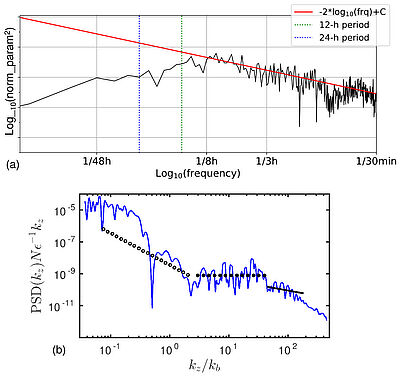Stratified Turbulence
How universal are the spectral distributions of wind and temperature in the middle atmosphere? What are the consequences of stratification and the earth rotation for the dynamics of middle atmosphere? It is a challenging question both to theoreticians and observers.
For the Kolmogorov-like turbulence, the whole energy cascade is governed by the spectral energy flux. In the dynamics of the middle atmosphere, this seems to hold for the mesoscale horizontal motion. The frequency spectrum of the mesoscale energy obtained by the SIMONe Argentina meteor radar system is provided in Figure 1(a). The theoretically verified frequency spectral slope of 𝑓-2 supports our statement that the mesoscale spectrum has a Kolmogorov-like form. The vertical wavenumber spectrum of the mesoscale energy is controlled by stratification. This spectrum has a 𝑘z-3 slope, as is shown with the open circle line in Figure 1(b). The data presented on this subplot was obtained within the WADIS-2 rocket campaign. In the extreme case of strong turbulence and stratification, turbulent structures of 500 – 100 meter vertical scales do not cascade the energy downwards, and the vertical spectrum becomes flat. This process is captured in Figure 1(b) and highlighted with the black dotted line.

At large horizontal scales, typically above 1000 km, we also expect the limit of inertial oscillations as the effects of Coriolis forces become significant. Although all limiting cases of rotation-, stratification-, and inertia-driven dynamic regimes are well known, the real challenge is to understand the transition stages between them and the role of gravity waves and coherent structures of the stratified turbulence in the dynamics of middle atmosphere.
In the IAP, we have high-resolution instruments and models to study how the energy cascades from several 1000 km down to meters scales in the rotating and stratified atmosphere. We combine expertise for theoretical models and numerical simulations, profiling and imaging radar, and lidar systems, as well as rocket soundings, for a joint effort of all three departments.
In result, since 2018 a number of publications emerged from collaboration of the optics, radar and modelling departments:
- V. Avsarkisov, E. Becker und T. Renkwitz, Turbulent parameters in the middle atmosphere: Theoretical estimates deduced from a gravity wave resolving general circulation model, J. Atmos. Sci., eingereicht, 2021.
- V. Avsarkisov und B. Strelnikov, On the kz-3 vertical energy spectrum in strongly stratified turbulence, J. Fluid Mech., eingereicht, 2021.
- J. L. Chau, J. M. Urco, V. Avsarkisov, J. P. Vierinen, R. Latteck, C. M. Hall und M. Tsutsumi, Four-dimensional quantification of Kelvin-Helmholtz instabilities in the polar summer mesosphere using volumetric radar imaging, Geophys. Res. Lett., 47, doi:10.1029/2019GL086081, 2020.
- J. Söder, C. Zülicke, M. Gerding und F.-J. Lübken, High-resolution observations of turbulence distributions across tropopause folds, J. Geophys. Res., 126(6), doi:10.1029/2020JD033857, 2021.
- T. Staszak, B. Strelnikov, R. Latteck, T. Renkwitz, M. Friedrich, G. Baumgarten und F.-J. Lübken, Turbulence generated small-scale structures as PMWE formation mechanism: Results from rocket campaign, J. Atmos. Solar-Terr. Phys., 217, doi:10.1016/j.jastp.2021.105559, 2021.
- B. Strelnikov, T. Staszak, R. Latteck, T. Renkwitz, I. Strelnikova, F.-J. Lübken, G. Baumgarten, J. L. Chau, J. Stude, M. Rapp, I. Hörner, S. Löhle, M. Eberhart, S. Fasoulas, M. Friedrich, Jörg Gumbel, J. Hedin, M. Hörschgen-Eggers, G. Giono und E. Belova, Sounding rocket project PMWE for investigation of polar mesosphere winter echoes, J. Atmos. Solar-Terr. Phys., doi:10.1016/j.jastp.2021.105596,, 2021.












